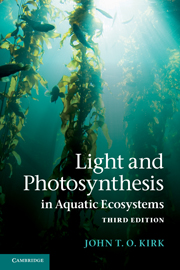Book contents
- Frontmatter
- Contents
- Preface to the third edition
- Part I The underwater light field
- 1 Concepts of hydrologic optics
- 2 Incident solar radiation
- 3 Absorption of light within the aquatic medium
- 4 Scattering of light within the aquatic medium
- 5 Characterizing the underwater light field
- 6 The nature of the underwater light field
- 7 Remote sensing of the aquatic environment
- Part II Photosynthesis in the aquatic environment
- References and author index
- Index to symbols
- Index to organisms
- Index to water bodies
- Subject index
- Plate Section
7 - Remote sensing of the aquatic environment
Published online by Cambridge University Press: 05 January 2013
- Frontmatter
- Contents
- Preface to the third edition
- Part I The underwater light field
- 1 Concepts of hydrologic optics
- 2 Incident solar radiation
- 3 Absorption of light within the aquatic medium
- 4 Scattering of light within the aquatic medium
- 5 Characterizing the underwater light field
- 6 The nature of the underwater light field
- 7 Remote sensing of the aquatic environment
- Part II Photosynthesis in the aquatic environment
- References and author index
- Index to symbols
- Index to organisms
- Index to water bodies
- Subject index
- Plate Section
Summary
In any water body some of the light that penetrates the water is caused, by scattering within the water, to pass up through the surface again. Of this emergent flux, 90% originates within the depth (equal to 1/Kd) in which downward irradiance falls to 37% (1/e) of the subsurface value. It can be regarded as a sample derived from the underwater light field, and so by studying it with appropriate detection instruments above the surface, information about that field, and therefore about the optically significant components of the medium, can be obtained. There is not much point in having detection instruments just above the surface: they would be more useful below. If, however, this emerging radiant flux can be studied by remote sensing instruments, located a considerable distance above the surface, in an aeroplane or space satellite, then the considerable advantage is gained that information about the underwater environment over a large area can be obtained in a short time. This makes it possible to acquire a synoptic view of a large aquatic ecosystem, with a fraction of the time and effort that would be involved in carrying out measurements over the same area from a surface vessel.
It will readily be appreciated, however, that a price must be paid. Measurements of the emergent flux, from a great distance, cannot be as accurate, or yield as much information, as measurements carried out within the water itself. We shall now consider the kinds of measurements that can be made, the correction procedures that must be carried out and the nature of the information that may be obtained. We shall then go on to examine some of the studies that have been carried out so far.
- Type
- Chapter
- Information
- Light and Photosynthesis in Aquatic Ecosystems , pp. 199 - 262Publisher: Cambridge University PressPrint publication year: 2010



